How Do I Turn My Buds Purple?
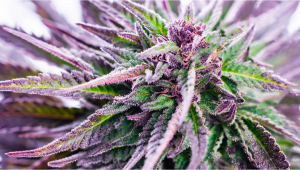
- 1. What’s the difference between green and purple buds?
- 2. Are purple buds more potent?
- 3. Which parts of the cannabis plant can turn purple?
- 3. a. Bracts
- 3. b. Trichomes
- 3. c. Pistils
- 3. d. Leaves
- 4. How to make my flowers turn purple?
- 4. a. Genetics
- 4. b. Bright light
- 4. c. Temperature
- 4. d. Ph at the roots
- 5. Fast buds purple strains
- 6. In conclusion
Purple weed buds really draw attention. It’s hard to believe but there are a lot of cannabis growers out there that will tell their customer’s purple weed is better or more potent than a standard green bud and this is completely wrong. Just like you can’t judge a book by its cover, you can’t judge a bud by its color. While the color of a bud does reflect part of its chemical profile, it doesn’t indicate its potency. There’s no correlation between purple weed and THC content—the marker for strength.
Potency aside, purple cannabis flowers are beneficial in other ways. For commercial growers, they make buds more unique and marketable. Such cannabis seeds also shake things up a bit for home growers and offer a completely different aesthetic experience. Now, it’s time to get to know purple weed on a deeper level. Below, you’ll find out what makes some cannabis buds purple, which part of the buds are able to emit this striking colour, and what you can do to boost the chances of your cannabis plants turning purple.
1. What’s The Difference Between Green and Purple Buds?
In most plants (including cannabis), the dominant pigment is chlorophyll. Chlorophyll is extremely efficient at capturing light energy because it can absorb nearly every wavelength of the visible light spectrum. In fact, the only wavelength it does not absorb and reflects is those in the “green” spectrum, that’s the reason why most plants appear green to the human eye.
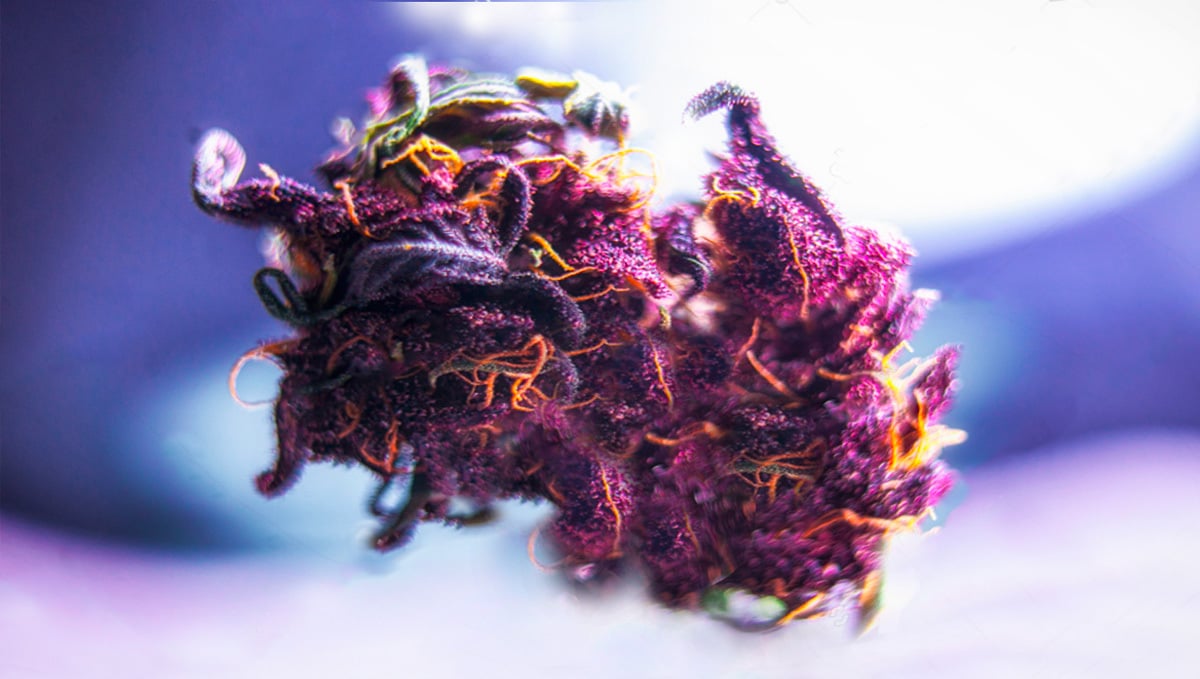
However, most plants have functional pigments other than chlorophyll and in the absence of chlorophyll, many plants will use anthocyanin or carotenoids (other pigments) to capture sunlight energy. Unlike chlorophyll, anthocyanins are stored in the vacuole of the cell and only appear once the chloroplasts fade, when this happens the plants can exhibit purple coloration. Cannabis plants contain hundreds of chemicals in total.
These compounds fall into several different groups. Most cannabis lovers and growers are more than familiar with cannabinoids such as THC and terpenes including myrcene and limonene. However, many people are unaware of the more than 20 flavonoids within cannabis. Flavonoids are polyphenolic compounds that serve a bunch of different roles in plants, including protection and communication.
Anthocyanins fall into this category. Much like chlorophyll, anthocyanins are also a plant pigment. However, instead of reflecting green light like chlorophyll, they reflect either purple, red, or blue, depending on the arrangement of the molecule. Why do cannabis plants produce anthocyanins? There are a number of reasons. They aren’t directly involved in photosynthesis, but they do serve a photoprotective function. By reflecting excess UV and visible light, and working as antioxidants, they help to shield photosynthetic parts of the plant.
In case you’ve never seen a purple cannabis plant before, make sure to check our Purple Punch Auto strain review video below. Now that you have a better idea of what purple weed or a purple weed strain is, you’ll get a better understanding of this article, so read along!
2. Are Purple Buds More Potent?
There’s no correct way to know if purple weed is more potent. The effect of a particular cannabis strain mainly comes down to cannabinoids. Among these, THC is the primary psychoactive component. The color of a cannabis flower does not determine its THC content. A green bud can have a THC content below 1%, and a purple bud can have a THC content of over 20%. Before you get too excited, the opposite is also true! The color of a bud has no influence on its psychoactive potency. The same logic also applies to taste. Terpenes underpin the aroma and flavor of different cannabis varieties. The level of anthocyanin within a flower doesn’t influence the level of terpenes, just like it doesn’t increase or decrease cannabinoid content.
In fact, purple weed can be more potent than green buds or vice-versa. But have in mind that color has nothing to do with it, it’s all about genetics. If you're a fan of purple strains, our LSD-25 with THC levels above 21% is just the right option.Every single person is different and can react differently to the same flowers. There are probably a lot of growers that swear purple weed is more potent. The truth is purple light contains the highest energy on the visible spectrum. So based on this we can assume purple bud can’t be more potent than green bud since purple flowers are reflecting and not absorbing the spectrum that produces the most energy.
3. Which Parts Of The Cannabis Plant Can Turn Purple?
Bracts
Bracts (the bud itself) are the small pods that make up your buds. Cannabis flowers are actually made up of hundreds of these small bracts stacked on top of one another. Even if not all the bracts change color, there are cases where some stay green, and others turn purple, resulting in a multi-colored bud. Overall, bracts are an extremely important part of cannabis flowers. They protect the sexual apparatus (stigma) and also the seeds following reproduction. For this reason, they feature the highest concentration of protective trichomes anywhere on the plant. They also contain photosynthetic pigments, so it makes sense that strains have visible anthocyanins in this anatomical region to deflect excess light that could otherwise be damaging.
Trichomes
Trichomes are the tiny glands that cover your buds. Cannabis plants express several different types of trichomes. Some of these are glandular in nature. They possess secretory disc cells that churn out valuable secondary metabolites such as terpenes and cannabinoids. These structures are responsible for the frosty appearance of high-quality cannabis flowers.
Even though they usually start clear, then cloudy, and later on become amber, it is possible to find genetics with purple or even pink trichomes. When viewed through a macro lens, it’s clear to see that some trichomes have anthocyanins moving up their stalks.
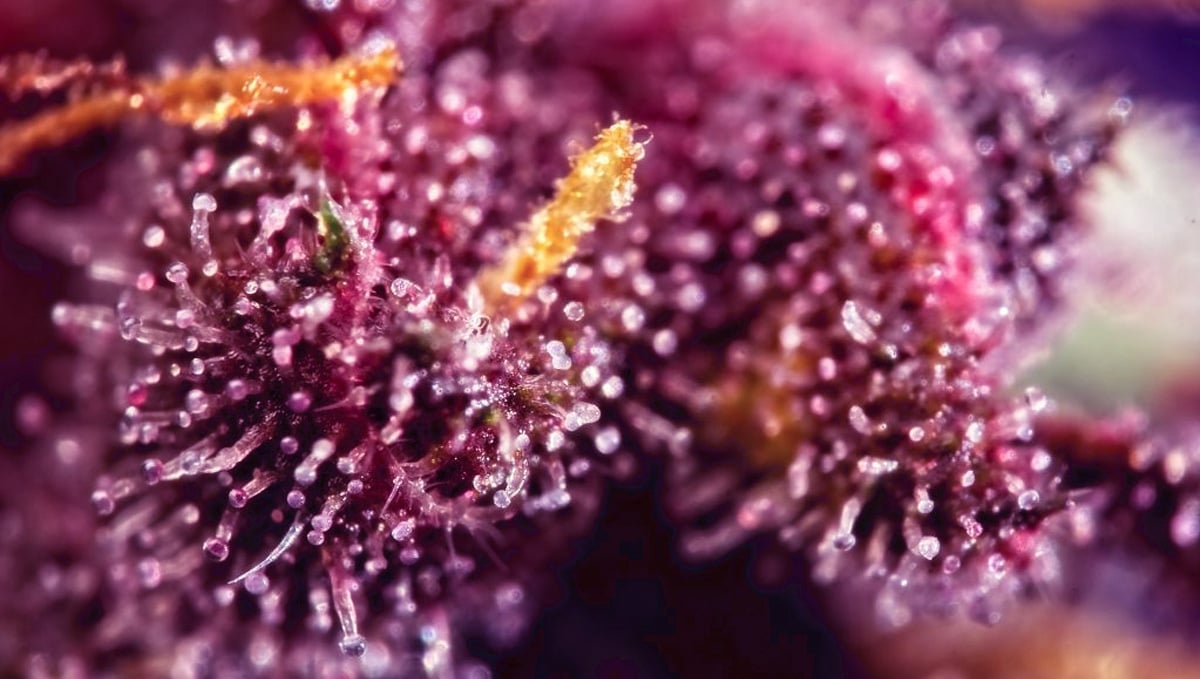
Pistils
Pistils are the fine hairs that pop out of your buds, letting you know they’re female. Pistils generally start a white color and turn orange/red/brown as plants mature. It is possible for your plant’s pistils to turn pink or purple, and this color will remain after you harvest, dry, and cure your buds.
Leaves
The fan and sugar leaves of your cannabis plant can also turn purple. Cannabis leaves can turn completely purple, but sometimes they only exhibit a purple coloration around the veins or the tips of the fingers.
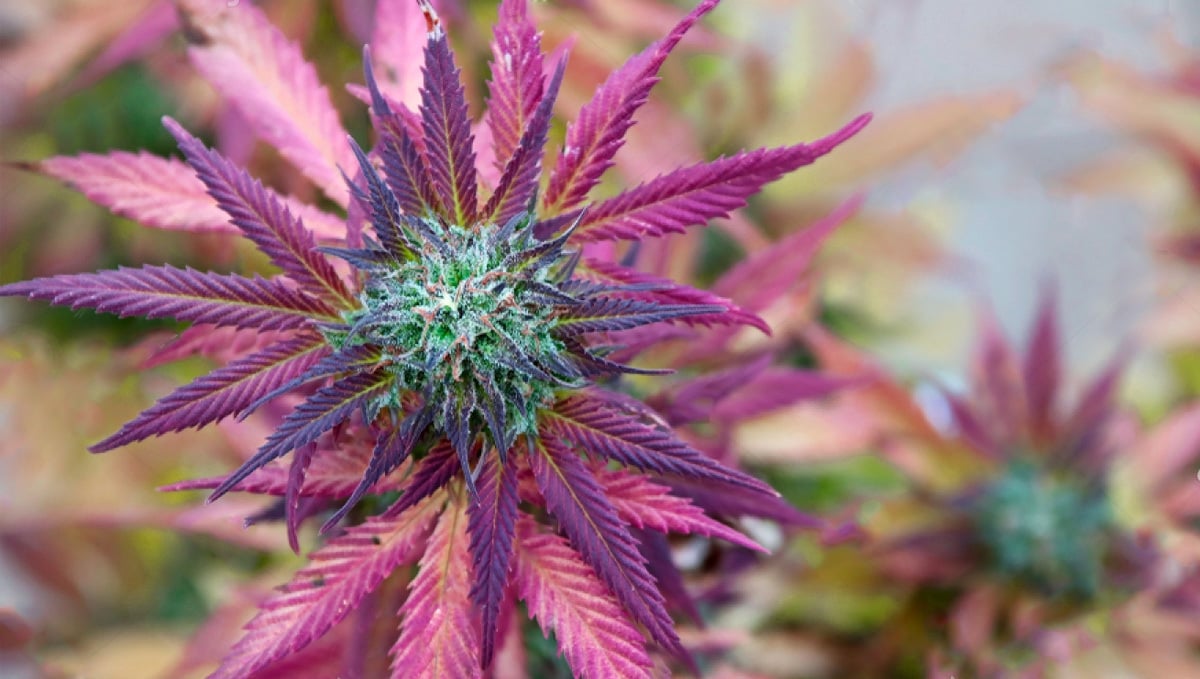
However, they usually won’t have a big effect on the final color of your buds. So you can trim away most of the leaves after or before drying.
4. How To Make My Flowers Turn Purple?
There are only two ways to correctly make your buds change color: genetics and temperature.
Genetics
Some strains will grow purple all on their own. If you are looking to grow purple weed strains you’ll get the best results by finding purple genetics like our Purple Lemonade. Skilled breeders have managed to create purple varieties through phenotype hunting and selective breeding. These processes help to narrow down genetic pools to varieties that feature metabolic pathways geared towards producing higher levels of anthocyanins.
These varieties still produce plenty of chlorophyll (they need to in order to survive), but create such high quantities of anthocyanins that they appear purple throughout much of the flowering stage of the growing cycle. These plants have been genetically selected to produce anthocyanin rather than chlorophyll and will grow purple on their own, you don’t have to do anything special to them.
Bright Light
In some cases, especially with LED fixtures, strong lights can help bring out different colors on cannabis plants. This happens because strong, direct light can end up destroying chlorophyll cells, thus promoting different tones such as red, pink, and purple. But, when this happens, the colors are more apparent on the parts of the cannabis plant that are getting the stronger light, so the rest will most likely stay green. When growing under HPS lights, this is uncommon but can also happen when growing under 400 W or higher wattage HPS bulbs, although growers mention that the colors are not as bright as when growing under LEDs.
Temperature
It seems like having a cooler night period can encourage cannabis plants to display red, pink, or purple colors. This does not work with all strains and while trying to change colors with low temperatures you may sometimes shock your plants, resulting in smaller yields. You can go as low as 13C (55F) with most strains and it shouldn’t be a problem, but remember you can cause permanent damage for some cold-sensitive strains.

Lower temperatures may help the plant turn purple but it may also likely slow plant growth, it’s generally not recommended for growers to lower down the temperature just to achieve colored buds, especially at the beginning of the flowering stage where you may actually be doing more harm than good.
PH At The Roots
There are a couple of plant species that are known to exhibit different colors based on the substrate’s pH. Even though it’s not confirmed, growers have noticed that different cannabis strains can exhibit slightly different colors on the leaves and buds depending on the pH levels. For example, purple strains tend to turn even more purple if the pH is below 6.0 but most strains will show signs of deficiency when the pH is below 6.0 so it’s not recommended to use this method if you’re a beginner.
In most cases, when the substrate’s pH is below 6.0, the purple, red or blue colors get even deeper but it’s most likely that most of the leaves get deficiencies so if you’re a beginner and want to try this, make sure you do it close to harvest so you can harvest your plant if something goes wrong.
5. Fast Buds Purple Strains
As we have already mentioned, your best chance at growing gorgeous purple ladies is to choose a strain that has purple genetics hardwired. Here at FastBuds, we have put more than a decade of blood, sweat, and tears into producing the finest autoflowering cultivars, and that includes strains that produce the most vibrant purples, pinks, and magenta hues. That’s not to say you cannot force any strain into producing these red spectrum colors through environmental changes, but if you are craving some purple goodness we suggest checking out the following options.
Banana Purple Punch
Banana Purple Punch Auto is one of our most awarded strains to date, and it is easy to see why it is so widely appreciated by growers and smokers alike. She is up there with the most potent autoflowering options on the market right now, sitting at plus 26% THC. She’s a true heavy hitter, with a Sativa 25%/Indica 75% split. The candy-like terpene profile comes in strong with a robust banana flavor base, which is backed up by an almost sour-patch background. This Indica dominant beauty grows to 120 cm, which is actually quite large for such an almost pure Indica auto. She is not only heavy on the THC punch, but also a huge yielder - capable of producing over 550gr/m2 when grown indoors, or 200 gr/plant when harnessing the sun’s rays outdoors. The high is well balanced, with a hint of euphoria mixed in with a large dose of couch-locking heaven. Be aware though, Banana Purple Punch Auto is the definition of a creeper - take your time and ease yourself into the majesty that this wonderful strain offers.
Purple Punch Auto
Another Indica dominant purple strain, but this one is a true super-auto! With growth that can reach above 150cm high and yield possibilities of over 600gr/m2 indoors and 200 gr/plant outdoors all while being one of the easiest strains to cultivate out of our whole range, it's no surprise that Purple Punch Auto is one of our top-sellers. This one is a hash makers’ dream, with trichome production at a level many thought unattainable only a few short years ago. The buds are a beautiful mix of light green tones with purple pockets popping up throughout the entire canopy by week 6 of flower, and they only become more pronounced as the grow comes to an end. Topping out at 24% THC, the high is powerful and a great whole-body experience. Sore muscles are quickly relaxed and soothing, with a nice dose of a creative head-buzz mixed in for good measure.
Purple Lemonade Auto
Many of our loyal growers think that is is our number one purple producing strain, and we are hard-pressed to disagree with them. Sure, it has a slightly lower THC count - up to 22% - than the previous two featured strains, but cannabis enjoyment is exclusively about how much THC is contained in the buds. The terpene and flavonoid profile has as much to do with the psychoactive effects as THC, with this strain being very unique as it comes in with both sweet and sour at the same time. This bittersweet palette is almost otherworldy and is hard to pass up once you have tried it. With a pure Californian genetic background, excellent bag appeal, and a hybrid split of 70% Indica/30% Sativa this is a true crowd-pleaser and one you should definitely try growing in your next cycle!
6. In Conclusion
True purple weed strains will turn purple no matter what you do in the environment, this lowers significantly the harm you can cause by lowering temperatures and will guarantee a 100% healthy purple plant, leaving you and your plant happy. In case you need help choosing purple genetics for your next grow cycle, here are more purple autoflowering strains that you may like.
| Strain | Sativa/Indica | THC |
|---|---|---|
| Blueberry Auto | 35% / 65% | 22% |
| Lemon Pie Auto | 50% / 50% | 24% |
| Blackberry Auto | 25% / 75% | 23% |
Just remember that purple weed or purple weed strains are not stronger than green buds because cannabinoid production does not depend on bud color. Purple cannabis buds are definitely beautiful but are basically the same as green buds, both buds contain cannabinoids, terpenes, flavonoids, and everything else; Obviously, there are differences between purple weed strains and green ones just like the differences you’ll find when growing different strains, but at the end of the day, purple weed is the same it just looks better. If you still want to grow your purple weed, remember that the main elements that affect bud color are:
- Genetics;
- Temperature;
- Lighting and;
- Possibly pH.
So make sure to take all of these into consideration and experiment on your next grow cycle if you want to harvest some beautiful purple marijuana buds.
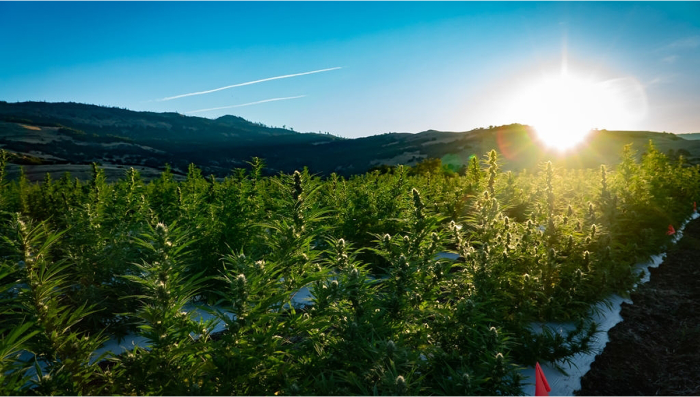







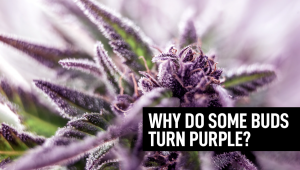





Comments